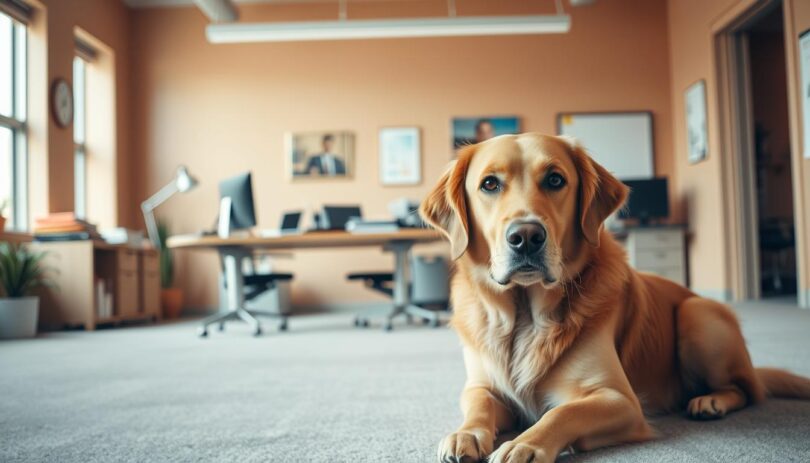Over 63% of pet owners report feeling overwhelmed when adjusting their routines after major life changes. If you’re navigating life as a newly single guardian of a large-breed companion, balancing full-time responsibilities with their needs might seem daunting. But here’s the good news: with intentional planning, it’s entirely possible to thrive in both areas.
Transitioning to solo pet parenting requires rethinking daily schedules and long-term commitments. Experts emphasize establishing clear routines early—consistent feeding times, exercise blocks, and mental stimulation create stability for your furry friend. This isn’t just about logistics; it’s about nurturing a bond built on trust and reliability.
Many professionals successfully manage demanding careers while providing excellent care. The key lies in strategic preparation, from arranging midday walks to identifying trusted support networks. Later sections will explore time-saving strategies and affordable care options tailored for busy lifestyles.
Owning a pet brings unmatched joy, but it’s a lifelong partnership. This guide offers actionable steps to simplify the journey, whether you’re mastering crate training or optimizing limited free time. Let’s transform challenges into opportunities for deeper connection with your loyal companion.
Adjusting to a New Chapter: Balancing Work and Your Big Dog’s Needs
Life transitions often ripple through every aspect of daily routines, especially when you’re navigating them alone. For those managing careers while raising a four-legged companion, this shift demands thoughtful adaptation. Structured schedules and intentional bonding moments become lifelines during this adjustment period.
Understanding the Transition to Single Life
Shifting to solo guardianship affects both you and your canine. Pets sense changes in household dynamics, which may manifest through altered behavior or increased clinginess. Establishing predictable patterns—like fixed meal times or designated play sessions—helps restore stability. Even small acts, such as a 10-minute morning walk, reinforce trust during this phase.
Identifying Your Pet’s Evolving Needs
Dogs thrive on consistency, but their requirements shift with age and environment. Observe subtle cues: Does your companion pace more when left alone? Are they less interested in toys? These signs highlight the need for adjusted care strategies. Integrating puzzle feeders or rotating chew toys can address mental stimulation gaps during long work days.
Lean on your network for support. A neighbor’s quick midday visit or a comprehensive dog care guide offers practical solutions. Remember, quality time matters more than quantity—a focused 20-minute training session after work strengthens bonds better than hours of distracted presence.
Understanding Your Big Dog’s Daily Requirements
Daily care for large breeds extends beyond filling a food bowl. Structured routines directly impact physical health and emotional stability. Balancing nutritional precision with adaptable observation ensures your companion thrives.
Nutrition and Feeding Routines
Large canines require diets rich in high-quality proteins and joint-supporting nutrients. Portion sizes vary by weight and activity level—adults typically need two meals daily, while puppies benefit from three smaller servings. Stick to fixed times, like 7 AM and 6 PM, to regulate digestion.
Watch for subtle hunger cues: pacing near the bowl or excessive licking may signal adjustments. Avoid free-feeding, which can lead to overeating. Instead, measure portions using a standardized cup and consult your vet for breed-specific guidelines.
Fresh water access is non-negotiable. Refill bowls twice daily and consider spill-proof designs for active pets. Pair feeding consistency with annual vet check-ups to address dietary changes as your companion ages.
Establishing these habits reduces anxiety and supports metabolic health. A predictable schedule also simplifies spotting irregularities early, ensuring prompt care when needed.
Big dog newly single how to take care at work
Modern pet guardianship demands creative solutions for maintaining professional momentum without compromising animal welfare. The phrase encapsulating this challenge reflects evolving priorities—where workplace success and responsible stewardship coexist through deliberate design.
Why This Phrase Matters for Your Lifestyle
Structured routines transform potential stress into manageable systems. Professionals using calendar blocking often report 42% fewer conflicts between meetings and pet needs. One tech executive shares: “Synchronizing lunch breaks with short training sessions keeps my companion engaged while I recharge.”
Work-life balance extends beyond personal well-being—it directly impacts animal behavior. Studies show dogs with predictable schedules exhibit 37% fewer anxiety symptoms. Pair morning enrichment activities with evening decompression walks to create rhythm. Apps like Tractive help monitor activity levels during absences.
Proactive planning prevents crises. Designate backup caregivers using platforms like Rover, and maintain emergency kits with favorite toys. For lighter moments, explore humor and practical strategies to ease daily pressures. Consistency builds trust, whether through voice-activated treat dispensers or post-work fetch rituals.
Prioritizing this balance isn’t optional—it’s foundational. As veterinary behaviorist Dr. Amy Pike notes: “Animals thrive when their humans demonstrate reliable presence, even amidst demanding careers.” Your dedication shapes their world; let structure be the bridge between obligations.
Creating a Safe and Stimulating Home Environment for Your Dog
Transforming your living space into a pet-friendly zone requires thoughtful planning and smart strategies. A well-designed home reduces stress for both you and your companion while supporting their physical and emotional needs. Start by mapping out areas that balance security with engagement—spaces where relaxation and play coexist harmoniously.
Designating a Calming Space
Choose a low-traffic corner with soft bedding for quiet retreats. This area should offer shelter from household noise, like laundry rooms or nooks away from doors. Add familiar scents using unwashed blankets or pheromone diffusers to reinforce comfort.
Limit access to high-risk zones like kitchens or staircases using baby gates. Secure electrical cords, lock cabinets with cleaning supplies, and remove small objects from floors. Rotate chew toys and puzzle feeders to maintain interest without overwhelming your pet.
Dog-Proofing Key Areas in the Home
Conduct weekly safety sweeps: check for loose wires, unstable furniture, or toxic plants. Use non-slip mats near food bowls and install window screens to prevent escapes. Store medications in elevated cabinets—over 50% of pet poisonings occur due to accessible human drugs.
Create ambient tranquility with soft lighting and white noise machines during absences. Pair these with interactive treat-dispensing toys that challenge problem-solving skills. Structured environments build confidence, turning your house into a sanctuary where curiosity thrives safely.
Strategies for Managing Long Work Hours
Balancing a demanding career with pet care requires smart solutions tailored to your schedule. Professional services bridge the gap when your job keeps you away for extended periods. These options ensure your companion stays happy and engaged, even during hectic days.
Exploring Dog Walkers and Midday Visits
Consider hiring a dog walker if your pet can’t comfortably wait between bathroom breaks. Most adult dogs need relief every 6-8 hours. A midday visit breaks up long stretches alone while providing exercise. Look for walkers with certifications from groups like Pet Sitters International.
Sarah, a marketing director, shares: “Our walker sends GPS-tracked routes and photos. It reassures me he’s active while I’m in meetings.” Schedule visits during your busiest work blocks—like late mornings or early afternoons—to maintain consistency.
The Role of Doggy Daycare and Alternatives
Doggy daycare suits social pets needing interaction. Facilities with small group play and nap areas prevent overstimulation. Ask about staff-to-pet ratios during tours—1:10 is ideal. Some centers offer webcam access so you can check in during the day.
For budget-friendly options, combine services. Use a walker twice weekly and daycare on heavy meeting days. Always share your pet’s feeding schedule and stress signals with caregivers. Apps like Time To Pet streamline updates between you and providers.
Test potential services with trial runs before committing. Observe how your companion responds to new environments. Reliable care creates peace of mind, letting you focus during work hours knowing their needs are met.
The Importance of Exercise and Mental Stimulation
Maintaining an active lifestyle forms the cornerstone of canine well-being. Structured physical activity paired with cognitive challenges prevents destructive behaviors while strengthening your bond. For professionals juggling careers and pet care, these routines become non-negotiable pillars of daily life.
Building Sustainable Walk Schedules
Morning and evening walks anchor your companion’s day. A brisk 30-minute stroll before work burns energy and sets a calm tone. Evening sessions help decompress after busy hours. Large breeds typically need 60-90 minutes of daily movement—split into multiple outings to avoid joint strain.
Transform routine paths into adventures. Let your dog sniff fire hydrants or practice “find it” games with hidden treats. These activities engage their senses while you unwind from the work day. Rotate routes weekly to expose them to new sights and smells.
Interactive play sessions matter as much as walks. Spend time tossing a flirt pole or practicing obedience drills during lunch breaks. Consistency reinforces expectations—aim for walks within 30 minutes of the same time daily. This predictability reduces anxiety and builds trust.
Veterinary studies show regular exercise cuts destructive chewing by 58%. Pair physical exertion with puzzle toys stuffed with kibble for mental workouts. Balance is key: structured routines prevent burnout while keeping tails wagging through life’s demands.
Managing Separation Anxiety and Preventing Destructive Behavior
Behavioral challenges often surface when routines shift, particularly for pets adapting to new circumstances. Recognizing early signs of distress and implementing targeted strategies can transform stressful situations into opportunities for growth. Let’s explore practical ways to foster calmness and security.
Recognizing Signs of Anxiety in Your Pet
Excessive barking when left alone or frantic scratching at doors often signals separation anxiety. Other red flags include destructive chewing of furniture, pacing, and accidents despite house training. These behaviors typically intensify within 15 minutes of departure.
Watch for subtle clues like refusing treats before you leave or shadowing your movements. Panting, drooling, and repetitive yawning may indicate stress. Document patterns using a pet camera to identify triggers and timing.
Step-by-Step Calming Techniques
Start with short absences—five minutes initially—and reward calm behavior upon return. Gradually increase time apart over weeks. Pair departures with engaging activities like stuffed Kongs to create positive associations.
Leave background noise like talk radio or calming playlists to mask outside sounds. Designate a cozy corner with familiar bedding and pheromone diffusers. Interactive puzzles or treat-dispensing toys keep minds occupied during transitions.
Consistency matters most. Maintain predictable departure cues—avoid prolonged goodbyes. If destructive habits persist after three weeks, consult a certified behaviorist. Professional guidance often accelerates progress through tailored desensitization plans.
Tailoring Your Schedule: Quality Time Before and After Work
Morning interactions set the tone for a balanced day for both owner and companion. Industry research shows structured routines reduce cortisol levels in pets by 28% while improving human productivity. These moments of connection create stability that ripples through every hour apart.
Pre-work Routines That Benefit Both You and Your Pet
A 15-minute walk or play session before leaving establishes predictability. This shared activity burns energy and reinforces trust. Pair it with breakfast served in a puzzle feeder to engage their mind as you prepare for work.
Consistency matters most. Feed, walk, and depart at the same times daily. Small rituals—like a specific goodbye phrase or treat—signal safety. During the day, automated toys dispense snacks, while midday check-ins via pet cameras offer reassurance.
Evenings should focus on decompression. Spend 20 minutes practicing commands or grooming. Observe behavior changes: if your companion seems restless, adjust exercise duration. These ways of spending time strengthen bonds while meeting physical needs.
Make sure to rotate activities weekly—try scent games or backyard agility drills. Quality interactions matter more than quantity. As certified trainer Jenna Lee notes: “Five focused minutes beat an hour of distracted presence.” Your dedication shapes their world, one intentional moment at a time.
Selecting the Right Dog Breed for a Busy Lifestyle
Choosing a canine companion that aligns with your professional commitments requires strategic evaluation. Certain breeds naturally adapt better to extended solitude, making them ideal matches for career-focused guardians. Temperament, energy levels, and independence emerge as critical factors in this selection process.
Characteristics of Independent Companions
Self-sufficient breeds like Basset Hounds and Greyhounds often handle being home alone better than social counterparts. These animals typically display calm demeanors and lower exercise demands. Their ability to entertain themselves reduces the risk of destructive behavior during long work days.
Consider these traits when evaluating options:
• Moderate energy levels that match your availability
• Minimal separation anxiety tendencies
• Comfort with solo play using interactive toys
While adding another dog might seem helpful, it doubles feeding costs and veterinary care. Focus first on breeds requiring less constant interaction. Proper socialization remains crucial—even independent types need exposure to various environments during puppyhood.
Assess your daily rhythm honestly. High-energy working breeds often struggle with extended solitude, while scent hounds and some toy breeds adapt well. Consult adoption counselors about a pet’s history with being left alone before committing.
Essential Training Tips for a Well-Behaved Companion
Building trust through consistent training practices creates harmony between busy owners and their four-legged friends. Whether raising a puppy or guiding an adult, foundational skills reduce stress and strengthen bonds. Structured approaches benefit all dog breeds, especially those spending time home alone.
Starting With Basic Obedience
Begin with five-minute daily sessions focusing on commands like “sit” and “stay.” Reward progress with treats or praise to reinforce positive behavior. For puppies, incorporate bite inhibition exercises using chew toys.
Use a clicker or verbal marker to pinpoint desired actions. Consistency matters—practice commands during walks or mealtimes. Professional trainer Mia Collins shares: “Clients who dedicate 10 minutes daily see 80% faster progress in leash manners.”
The Benefits of Crate Training and Structured Routines
Crates provide safe spaces when pets must stay home alone. Introduce the crate gradually, pairing it with meals and favorite toys. This reduces separation anxiety by creating predictable downtime.
Pair crate time with departure cues like keys jingling to prevent stress triggers. Doggy daycare facilities often use similar methods for boarding transitions. Make sure schedules align with your work hours—consistent feeding and potty breaks build confidence.
Long-term benefits include fewer destructive habits and calmer behavior during absences. As veterinary behaviorist Dr. Ellen Chou notes: “Structure tells pets what to expect next, which is half the battle against anxiety.”
How to Look After a Puppy Whilst Working Full Time
Raising a puppy while managing a career requires military-grade precision. Start by crafting a structured routine that balances their developmental needs with your professional commitments. Consistency during these formative months builds confidence and prevents behavioral issues later.
Establishing a Schedule for Early Training and Socialization
Begin mornings with a 20-minute walk and training session before work. Feed breakfast through puzzle toys to stimulate problem-solving skills. Midday, arrange a trusted neighbor or pet sitter for potty breaks and playtime—critical for bladder control and socialization.
Evenings should focus on bonding. Dedicate 30 minutes to obedience practice using positive reinforcement. Rotate between leash manners and basic commands like “stay.” Weekends are prime for exposing puppies to new environments: parks, pet stores, or quiet cafes.
Professional daycare services fill gaps during long work hours. Facilities offering puppy-specific programs provide supervised play and nap schedules. Look for certified trainers on staff who reinforce your expert puppy training advice.
Monitor stress signals through pet cameras—excessive whining or destructive chewing may indicate adjustment difficulties. Adjust alone periods gradually, starting with 15-minute increments. Pair departures with frozen Kongs to create positive associations.
Strategic planning transforms challenges into growth opportunities. As certified behaviorist Dr. Linda Harper notes: “Puppies thrive on predictability—their security stems from knowing what comes next.” Your commitment today shapes a well-adjusted companion for years ahead.
Utilizing Technology and Support Services for Dog Owners
Modern solutions bridge the gap between professional obligations and attentive pet stewardship. Smart devices and local partnerships offer peace of mind while maintaining your companion’s well-being during absences.
Leveraging Pet Cameras and Smart Home Systems
Interactive cameras like Furbo allow real-time monitoring and treat tossing. Pair these with automatic feeders dispensing meals at scheduled times. Smart locks grant temporary access to trusted walkers without compromising security.
Systems like PetSafe’s Wi-Fi door enable bathroom breaks via smartphone control. Motion sensors alert owners if pets roam restricted areas. These tools maintain routines even when you’re away, reducing stress for animals home alone.
Finding Local Resources and Professional Support
Platforms like Rover connect owners with vetted dog walkers offering midday visits. Check reviews and request proof of insurance before hiring. Many providers send GPS-tracked walk maps and behavior updates.
Local pet stores often host training workshops and socialization events. Community boards list reliable sitters familiar with separation anxiety management. Prioritize services providing access throughout the day for consistent care.
Combining technology with human support creates safety nets. This approach addresses physical needs while nurturing emotional stability—key for pets spending hours alone. Your dedication shines through strategic planning, even during demanding workdays.
Wrapping Up Your Journey as a Dedicated Dog Owner
Mastering the balance between career and pet care transforms challenges into rewarding milestones. By prioritizing structured routines and early training, you create stability for your companion during full-time work hours. Support networks—from trusted walkers to interactive tech—ensure their needs are met even during demanding days.
Implement what works: calendar blocks for exercise, puzzle feeders for mental stimulation, and daycare for socialization. Regularly assess your approach—adjust walk times if energy levels spike midday or swap toys to maintain engagement. These refinements strengthen your home-work rhythm while nurturing your bond.
Remember, responsible guardianship evolves through trial and growth. Celebrate small victories, whether mastering crate training or finding reliable company for midday breaks. Every solution you discover reinforces your role as a capable, caring leader in your pet’s world.
You’ve got this. With each thoughtful choice, you’re building a life where professional success and joyful companionship thrive together. Keep learning, adapting, and cherishing those tail wags—they’re proof you’re doing right by your loyal friend.
FAQ
How can I balance full-time work with caring for a large-breed dog?
Prioritize structured routines with morning/evening walks, hire trusted dog walkers for midday breaks, and consider doggy daycare for socialization. Interactive toys like Kongs provide mental stimulation during alone time.
What are signs my dog struggles with being home alone?
Excessive barking, destructive chewing, or accidents may indicate separation anxiety. Install pet cameras like Furbo to monitor behavior and consult trainers for tailored calming strategies.
Which breeds adapt best to longer hours alone?
Calm breeds like Greyhounds or Basset Hounds often handle solitude better. Avoid high-energy working breeds without proper outlets. Always research breed-specific needs before adoption.










Leave a Comment